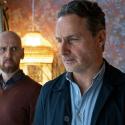Most people’s experience of the 120 or so Victorian asylums that littered the UK landscape for more than a century is, thankfully, oohing and aahing over the “sophisticated and sensitive” conversions they have become, providing “astonishing, unusual and stylish” apartments, as estate-agent-speak has it. Those fortunate enough to move into these beautiful new homes are doing so of their own accord, of course, but many of those held in their previous incarnations would have preferred to be anywhere else at all.
This documentary, made by Chris Boulding for the BBC’s Open University strand, provided a fascinating glimpse behind what were, for most of the asylums’ existence, firmly closed doors where, as one former nurse had it, patients would be better described as inmates. At their worst, he said, asylums were places where people were “dumped”, either by their family or the local authority; many were socially inadequate rather than mentally unwell and could be conveniently forgotten about once they were locked up.
But the film wasn’t all gloom and doom; its focus was on High Royds in Yorkshire, acknowledged as one of the more enlightened establishments and for many years a world leader in research into treatment of the mentally ill. Opened in 1888, it was one of the very last asylums to close, in 2003, and at its height was like a small town in itself, with 2,500 patients, comfortable accommodation in its extensive grounds for its staff, a library, a butcher, baker, cobbler and a dairy. It even had its very own railway station. It was, as High Royds’ fascinating online archive informs us, “a truly magnificent example of J Vickers Edwards architecture”.
High Royds sounds like a holiday camp compared to other institutions mentioned in the film, where dubious treatments - cack-handed lobotomies, ECT given for no discernible purpose, routine use of the anti-psychotic drug Largactil (aka the chemical cosh), even “insulin therapy”, in which patients were put into insulin-induced comas in the horribly mistaken belief that their minds would be cleansed of their demons when they awoke - were routine in years gone by. Archive footage of those treatments was shocking to watch, as were the first-hand accounts by former asylum patients, whose ailments would nowadays be recognised as post-traumatic stress disorder or mild depression. Decades later, their anger at misguided treatment and surgery almost jumped out of the screen.
The film threw up some fascinating facts, including one completely new to me - that Enoch Powell, that most maverick of politicians, was the first government minister to recognise that asylum regimes were an affront to human decency and that a more patient-based system of care needed to be introduced. His plan was formulated in 1961 and was the foundation of “care in the community”, which was enshrined in law only in 1990. The asylums were emptied almost overnight, leaving tens of thousands of people, most of them institutionalised after decades in care, unable to cope with everyday life. Support systems laid out in the 1990 Act were mostly not in place and many ex-patients found homes only in hostels run by the Salvation Army and other charities. Later, the system became discredited when former asylum patients committed serious crimes because they were no longer taking their medication - no wonder the system is known in some circles as “scare in the community”.
This was a fascinating programme, but Boulding was trying to do too much; part history of Victorian asylums, part history of psychiatric treatments, part social documentary on how the mentally ill are treated in the UK. I found the non-linear timeline confusing and it was also irritatingly even-handed - was emptying the asylums really a chance for “patients to start a new life” and “find a new self-confidence”, as the narration (read by Tamsin Greig) had it, or was care in the community a huge failure as, they told us, former health secretary Frank Dobson later admitted?
The asylums were not the problem per se; we know some people need to be in care for their and the wider community’s safety, and psychiatric treatment poses the eternal debate of individual versus collective rights. Perhaps the most honest appraisal was given by eminent psychiatrist Dr Henry Rollin, who said of care in the community, “I don’t think the community cares". Couldn’t have put it better myself.















Add comment